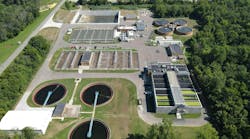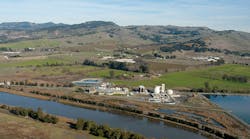Situated across the Potomac River from the city of Alexandria, Va., is the Blue Plains Advanced Wastewater Treatment Plant, which holds the title of largest advanced wastewater treatment plant in the world.
“There are larger plants in the world—but not doing tertiary (or advanced) wastewater treatment; they stop at secondary treatment,” said Pamela Mooring, external communications manager for the District of Columbia Water and Sewer Authority (DC Water). “It will soon be the largest installation of Cambi in the world and will be the first Cambi installation in North America.”
Waste Reduction, Energy Generation & Better Air Quality
The Cambi thermal hydrolysis process (THP) is used to “pressure cook” sludge before feeding it into the anaerobic digesters. The process was designed and built by CDM Smith and PC Construction Co. in a joint venture. Cambi is an environmental technology provider based in Asker, Norway. CDM Smith has implemented THP in Europe, where several facilities are currently using this technology to process hydrolyzed sludge. The end result is combined heat and power and a Class A biosolid product. DC Water will achieve savings in electricity and by using the Class A product locally, thereby eliminating annual costs of hauling fees. As a result, the facility will be able to generate power from biogas while significantly reducing the volume of biosolids hauled away.
There also is the potential to create a fertilizer product for profit.
Blue Plains treats an annual average of 300 million gal per day (mgd) and has a design capacity of 370 mgd, with a peak wet-weather design capacity to treat more than 1 billion gal per day.
“With 153 acres of treatment processes, Blue Plains has used every available acre,” Mooring said. “Any additional capacity, or more stringent treatment mandates, will require some unique solutions. Discharging into the Potomac River, a tributary to the Chesapeake Bay—a delicate ecosystem—means that we have one of the most stringent permits in the world. About one-third of the district has a combined sewer system ... Fortunately, Blue Plains is home to a world-renowned research team.”
To become more sustainable, the Cambi digester project will allow DC Water to harness the resources in the solids left over at the end of the treatment process. In addition, DC Water is aiming to add solar panels on top of its treatment tanks in 2015 to provide additional energy capture.
DC Clean Rivers Project
Another major project from DC Water is designed to capture and provide storage for combined sewer overflow (CSOs) being discharged to the Anacostia River.
“DC Water is addressing its combined sewer system with a combination of tunnel systems (grey solutions) and green infrastructure (green solutions),” Mooring said. “The tunnels will hold combined storm water and sewage during intense rainstorms and then release it when the storms subside, where it will convey to Blue Plains for treatment.”
The Anacostia River tunnel construction is currently underway. The shaft into which DC Water lowered its first tunnel boring machine (TBM) is located at Blue Plains (where the tunnel will end). Tunneling began in July 2013. A new TBM will be lowered underground in the coming months to tunnel a northerly portion of the same tunnel.
The DC Clean Rivers Project is a $2.6 billion program to significantly reduce CSOs to district waterways. The $470 million anaerobic digestion project will help DC Water recoup energy from the wastewater treatment process, reduce costs and create a Class A biosolid suitable as fertilizer.
“Additionally, DC Water just finished its [approximately] $1 billion Enhanced Nutrient Removal Project to meet the new U.S. Environmental Protection Agency permit levels for nitrogen,” Mooring said. “The facilities included more tankage and a new pumping station.”
Download: Here


